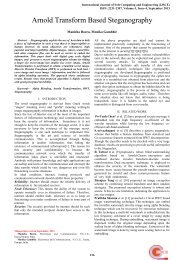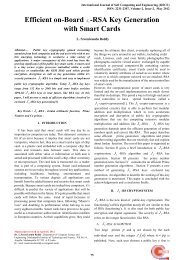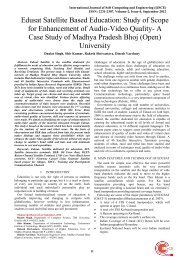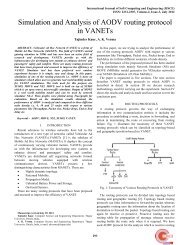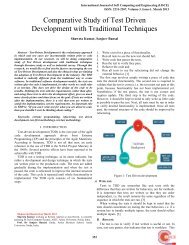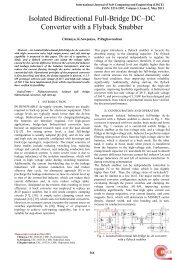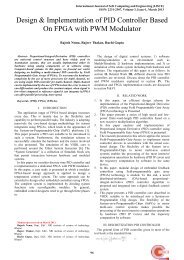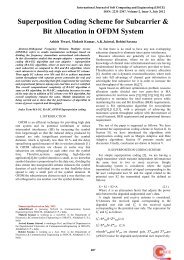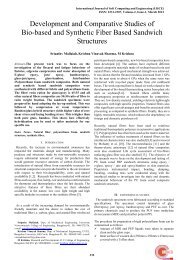To Improve Security in Cloud Computing with Intrusion detection ...
To Improve Security in Cloud Computing with Intrusion detection ...
To Improve Security in Cloud Computing with Intrusion detection ...
Create successful ePaper yourself
Turn your PDF publications into a flip-book with our unique Google optimized e-Paper software.
International Journal of Soft Comput<strong>in</strong>g and Eng<strong>in</strong>eer<strong>in</strong>g (IJSCE)<br />
ISSN: 2231-2307, Volume-3, Issue-2, May 2013<br />
<strong>To</strong> <strong>Improve</strong> <strong>Security</strong> <strong>in</strong> <strong>Cloud</strong> Comput<strong>in</strong>g <strong>with</strong><br />
<strong>Intrusion</strong> <strong>detection</strong> system us<strong>in</strong>g Neural<br />
Network<br />
Richa Sondhiya, Maneesh Shreevastav, Mahendra Mishra<br />
<br />
Abstract— <strong>Cloud</strong> comput<strong>in</strong>g is a new type of service which<br />
provides large scale comput<strong>in</strong>g resource to each customer. <strong>Cloud</strong><br />
Comput<strong>in</strong>g Systems can be easily threatened by various<br />
cyber-attacks, because most of <strong>Cloud</strong> comput<strong>in</strong>g system needs to<br />
conta<strong>in</strong> some <strong>Intrusion</strong> Detection Systems (IDS) for protect<strong>in</strong>g<br />
each Virtual Mach<strong>in</strong>e (VM) aga<strong>in</strong>st threats. In this case, there<br />
exists a tradeoff between the security level of the IDS and the<br />
system performance. If the IDS provide stronger security service<br />
us<strong>in</strong>g more rules or patterns, then it needs much more comput<strong>in</strong>g<br />
resources <strong>in</strong> proportion to the strength of security. So the amount<br />
of resources allocat<strong>in</strong>g for customers decreases. Another problem<br />
<strong>in</strong> <strong>Cloud</strong> Comput<strong>in</strong>g is that, huge amount of logs makes system<br />
adm<strong>in</strong>istrators hard to analyze them. In this paper, we propose a<br />
method that enables cloud comput<strong>in</strong>g system to achieve both<br />
effectiveness of us<strong>in</strong>g the system resource and strength of the<br />
security service <strong>with</strong>out trade-off between them. In this paper, we<br />
propose a soft Comput<strong>in</strong>g technique such as MLP Algorithm for<br />
detect<strong>in</strong>g the unknown <strong>in</strong>trusion <strong>in</strong> network <strong>in</strong>trusion <strong>detection</strong> <strong>in</strong><br />
cloud comput<strong>in</strong>g environment.<br />
Index Terms— <strong>Cloud</strong> Comput<strong>in</strong>g, Neural Network, <strong>Intrusion</strong><br />
<strong>detection</strong> system<br />
I. INTRODUCTION<br />
Design<strong>in</strong>g <strong>Intrusion</strong> Detection System <strong>in</strong> <strong>Cloud</strong><br />
Comput<strong>in</strong>g Environment is one of the most critical tasks. The<br />
development of the technology and hardware, we can imag<strong>in</strong>e<br />
that it is possible to get rid of the great mass of the spend<strong>in</strong>g<br />
for fixed assets, such as expensive networks server and<br />
software. Just a web browser can help us complete our<br />
common bus<strong>in</strong>ess applications onl<strong>in</strong>e from the provider on<br />
<strong>in</strong>ternet. This is the idea the cloud comput<strong>in</strong>g providers<br />
de-scribe to us. But security <strong>in</strong> cloud comput<strong>in</strong>g environment<br />
is of major concern. <strong>Intrusion</strong> Detection Systems (IDSs) are<br />
amongst the ma<strong>in</strong> tools for provid<strong>in</strong>g security <strong>in</strong> networks,<br />
cloud and grid. Network traffic data, provided for the design<br />
of <strong>in</strong>trusion <strong>detection</strong> system, which <strong>in</strong>cludes rich <strong>in</strong>formation<br />
about system and user behavior, but the raw data itself, can be<br />
difficult to analyze due to its large size. The major issue or<br />
key challenges <strong>in</strong> network security is to be<strong>in</strong>g able to reduce<br />
data size. Due to this large data set, classification techniques<br />
require a huge amount of memory and CPU resource.<br />
<strong>To</strong> re-duce the number of computer resources, both<br />
memory and CPU time, Dimensionality reduction is the key<br />
concept.<br />
The feature space hav<strong>in</strong>g reduced features truly contributes<br />
to classification that cuts pre-process<strong>in</strong>g costs and m<strong>in</strong>imizes<br />
the effects of the „peak<strong>in</strong>g phenomenon‟ <strong>in</strong> classification.<br />
Thereby improv<strong>in</strong>g the overall performance of classifier<br />
based <strong>in</strong>trusion <strong>detection</strong> systems.<br />
II. CLOUD COMPUTING ENVIRONMENT<br />
The <strong>Cloud</strong> Comput<strong>in</strong>g is one of the emerg<strong>in</strong>g technologies <strong>in</strong><br />
the world. It is an Internet-based comput<strong>in</strong>g technology,<br />
where shared resources such as software, platform, storage<br />
and <strong>in</strong>formation are provided to customers on demand. <strong>Cloud</strong><br />
comput<strong>in</strong>g is a technology by which dynamically scalable and<br />
virtualized resources are provided to the users over the<br />
Inter-net. <strong>Cloud</strong> comput<strong>in</strong>g customers do not own the<br />
physical <strong>in</strong>frastructure, thereby avoid<strong>in</strong>g capital expenditure.<br />
They rent resources from a third-party provider, consume<br />
them as a ser-vice and pay only for resources that they use<br />
[10]. Three primary models for <strong>Cloud</strong> Comput<strong>in</strong>g have<br />
emerged:<br />
A. Software as a Service (SaaS)<br />
Applications (word processor, CRM, etc.) or application<br />
ser-vices (schedule, calendar, etc.) execute <strong>in</strong> the ‚cloud‛<br />
us<strong>in</strong>g the <strong>in</strong>terconnectivity of the <strong>in</strong>ternet to propagate data<br />
[4].<br />
B. Platform as a Service (PaaS)<br />
Applications are built <strong>in</strong> the ‚cloud‛ on the platform us<strong>in</strong>g a<br />
variety of technologies [4].<br />
C. Infrastructure as a Service (IaaS)<br />
Compute resources (processors, memory, storage, bandwidth,<br />
etc.) are provided <strong>in</strong> an as-needed, pay-as-you-go model. IaaS<br />
is able to provide from s<strong>in</strong>gle server up to entire data centers<br />
[6].<br />
In this paper, we propose a soft Comput<strong>in</strong>g technique such as<br />
MLP Algorithm for detect<strong>in</strong>g the unknown <strong>in</strong>trusion <strong>in</strong><br />
network <strong>in</strong>trusion <strong>detection</strong> <strong>in</strong> cloud comput<strong>in</strong>g environment.<br />
Fig1 shows a basic cloud network. Fig shows cloud<br />
conta<strong>in</strong><strong>in</strong>g servers which provide services to user. <strong>Cloud</strong><br />
provide various types of services. It provide storage,<br />
<strong>in</strong>frastructure, platform as a service. <strong>Cloud</strong> works <strong>in</strong><br />
pay-as-you-go basis, that means we have to pay accord<strong>in</strong>g to<br />
services which we use. <strong>Cloud</strong> covers broad category of<br />
services.<br />
Manuscript received May, 2013.<br />
Richa Sondhiya, Department of Information Technology, L.N.C.T.<br />
Bhopal, India.<br />
Maneesh Shreevastav, Department of Information Technology,<br />
L.N.C.T. Bhopal,India.<br />
Mahendra Mishra, Department of Information Technology, L.N.C.T.<br />
Bhopal, India.<br />
401
<strong>To</strong> <strong>Improve</strong> <strong>Security</strong> <strong>in</strong> <strong>Cloud</strong> Comput<strong>in</strong>g <strong>with</strong> <strong>Intrusion</strong> <strong>detection</strong> system us<strong>in</strong>g Neural Network<br />
attributes from known malicious threats. This is similar to the<br />
way most antivirus software detects malware. The issue is that<br />
there will be a lag between a new threat be<strong>in</strong>g discovered <strong>in</strong><br />
the wild and the signature for detect<strong>in</strong>g that threat be<strong>in</strong>g<br />
applied to your IDS. Dur<strong>in</strong>g that lag time your IDS would be<br />
unable to detect the new threat.<br />
Fig 1: A Basic <strong>Cloud</strong> Network<br />
III. INTRUSION DETECTION SYSTEM<br />
An <strong>Intrusion</strong> Detection System (IDS) constantly monitors<br />
actions <strong>in</strong> a certa<strong>in</strong> environment and decides whether they are<br />
part of a possible hostile attack or a legitimate use of the<br />
environment. The environment may be a computer, several<br />
computers connected <strong>in</strong> a network or the network itself. The<br />
IDS analyzes various k<strong>in</strong>ds of <strong>in</strong>formation about actions<br />
emanat<strong>in</strong>g from the environment and evaluates the probability<br />
that they are symptoms of <strong>in</strong>trusions. Such <strong>in</strong>formation<br />
<strong>in</strong>cludes, for example, configuration <strong>in</strong>formation about the<br />
current state of the system, audit <strong>in</strong>formation describ<strong>in</strong>g the<br />
events that occur <strong>in</strong> the system (e.g., event log <strong>in</strong> W<strong>in</strong>dows<br />
XP), or network traffic. Several measures for evaluat<strong>in</strong>g IDS<br />
have been suggested (Debar et al. 1999; Richards 1999;<br />
Spafford and Zamboni 2000; Balasubramaniyan et al. 1998).<br />
These measures Include accuracy, completeness,<br />
performance, efficiency, fault tolerance, timel<strong>in</strong>ess, and<br />
adaptively. The more widely used measures are the True<br />
Positive (TP) rate, that is, the percentage of <strong>in</strong>trusive actions<br />
(e.g., error related pages) detected by the system, False<br />
Positive (FP) rate which is the percentage of normal actions<br />
(e.g., pages viewed by normal users) the system <strong>in</strong>correctly<br />
identifies as <strong>in</strong>trusive, and Accuracy which is the percentage<br />
of alarms found to represent abnormal behavior out of the<br />
total number of alarms. In the current research TP, FP and<br />
Accuracy measures were adopted to evaluate the performance<br />
of the new methodology. There are IDS that simply monitor<br />
and alert and there are IDS that perform an action or actions <strong>in</strong><br />
response to a detected threat. We‟ll cover each of these<br />
briefly.<br />
IV. TYPE OF INTRUSION DETECTION SYSTEM<br />
A. NIDS<br />
Network <strong>Intrusion</strong> Detection Systems are placed at a strategic<br />
po<strong>in</strong>t or po<strong>in</strong>ts <strong>with</strong><strong>in</strong> the network to monitor traffic to and<br />
from all devices on the network. Ideally you would scan all<br />
<strong>in</strong>bound and outbound traffic; however do<strong>in</strong>g so might create<br />
a bottleneck that would impair the overall speed of the<br />
network.<br />
B. HIDS<br />
Host <strong>Intrusion</strong> Detection Systems are run on <strong>in</strong>dividual hosts<br />
or devices on the network. A HIDS monitors the <strong>in</strong>bound and<br />
outbound packets from the device only and will alert the user<br />
or adm<strong>in</strong>istrator of suspicious activity is detected<br />
C. Signature Based<br />
A signature based IDS will monitor packets on the network<br />
and compare them aga<strong>in</strong>st a database of signatures or<br />
D. Anomaly Based<br />
An IDS which is anomaly based will monitor network<br />
traffic and compare it aga<strong>in</strong>st an established basel<strong>in</strong>e. The<br />
basel<strong>in</strong>e will identify what is “normal” for that network- what<br />
sort of bandwidth is generally used, what protocols are used,<br />
what ports and devices generally connect to each other- and<br />
alert the adm<strong>in</strong>istrator or user when traffic is detected which is<br />
anomalous, or significantly different, than the basel<strong>in</strong>e.<br />
V. LITERATURE SURVEY<br />
Multiple research activities were <strong>in</strong>troduced to address the<br />
issue of <strong>in</strong>trusion <strong>detection</strong> <strong>with</strong><strong>in</strong> cloud comput<strong>in</strong>g<br />
environments.<br />
Dastjerdi et. al. [7] implemented applied agent-based IDS as<br />
a security solution for the cloud. The model they proposed<br />
was an enhancement of the DIDMA [8]. The system is ma<strong>in</strong>ly<br />
designed to protect the networks‟ resources and cannot be<br />
customized as a service.<br />
Bakshi et. al. [9] proposed another cloud <strong>in</strong>trusion <strong>detection</strong><br />
solution. The ma<strong>in</strong> concern was to protect the cloud from<br />
DDoS attacks. The model uses an <strong>in</strong>stalled <strong>in</strong>trusion <strong>detection</strong><br />
system on the virtual switch and when a DDoS attack is<br />
detected. Despite be<strong>in</strong>g reported as effective, the model helps<br />
to protect the cloud itself, not the cloud clients who <strong>in</strong> turn<br />
don‟t have any k<strong>in</strong>d of authority over the <strong>in</strong>trusion <strong>detection</strong><br />
system be<strong>in</strong>g used.<br />
Mazzariello et. al. [10] Another recent and significant<br />
contribution to this field is the work of where they proposed a<br />
model for detect<strong>in</strong>g DoS attacks aga<strong>in</strong>st Session Initiation<br />
Protocol(SIP). The model is limited to detect<strong>in</strong>g SIP flood<strong>in</strong>g<br />
attacks and falls largely <strong>with</strong> the category of <strong>in</strong>trusion<br />
<strong>detection</strong> systems designed to protect the cloud itself.<br />
Lo et. al. [11] proposed a framework that is ma<strong>in</strong>ly designed<br />
to create cloud networks that are immune aga<strong>in</strong>st the<br />
Distributed Denial of Service (DDoS) attacks [12]. The<br />
utilized IDS implementation was the Open Source Snort IDS<br />
and the framework itself is designed as a Distributed <strong>Intrusion</strong><br />
Detection System (DIDS) [13] [14]. The proposed framework<br />
supports the idea of cooperative defense by the IDS sensors <strong>in</strong><br />
the cloud network. With<strong>in</strong> the framework, an IDS sensor is<br />
deployed <strong>in</strong> each network region. Any sensor will send out the<br />
alert to the other sensors while they are suffer<strong>in</strong>g from a<br />
severe attack def<strong>in</strong>ed <strong>in</strong> its block table. Each sensor<br />
exchanges its alerts and has a judgment criterion to evaluate<br />
the trustworth<strong>in</strong>ess of these alerts. After evaluation, the new<br />
block<strong>in</strong>g rule is added <strong>in</strong>to the block table if the alerts are<br />
regarded as a new k<strong>in</strong>d of attack.<br />
Roschke et. al. [15] have proposed an <strong>in</strong>trusion <strong>detection</strong><br />
framework based on the VM-based IDS [16]. In their work,<br />
they have developed a general framework for <strong>in</strong>trusion<br />
<strong>detection</strong>. It consisted of separate IDS sensors for each virtual<br />
host. The IDS sensors can be of different vendors. <strong>To</strong> enable<br />
the collection and correlations of alerts from the different IDS<br />
implementations, an Event Gatherer was made to work as a<br />
medium to standardize the output from the different sensors as<br />
well as realize the logical communication. The cloud user can<br />
402
International Journal of Soft Comput<strong>in</strong>g and Eng<strong>in</strong>eer<strong>in</strong>g (IJSCE)<br />
ISSN: 2231-2307, Volume-3, Issue-2, May 2013<br />
have access to both the applications and the IDS sensors. The<br />
users can access the sensors, configure, modify rule sets, and<br />
modify <strong>detection</strong> thresholds. Additionally, users can review<br />
the alerts generated when attacks that target their virtual hosts<br />
or services are spotted. The framework also <strong>in</strong>cludes the IDS<br />
Management module which is responsible for orchestrat<strong>in</strong>g<br />
the message pass<strong>in</strong>g and alert transfer among the different<br />
IDS sensors and the ma<strong>in</strong> storage unit whether it was a file<br />
system, a network database, or a shared folder. This approach<br />
of separat<strong>in</strong>g the IDS from the protected hosts is of great<br />
advantage. But it is criticized for requir<strong>in</strong>g the large<br />
consumption of comput<strong>in</strong>g resources s<strong>in</strong>ce every virtual<br />
application, platform, or host needs a separate VM-Based<br />
IDS.<br />
VI. TRADITIONAL TECHNIQUE USED IN IDS<br />
A. Cluster<strong>in</strong>g Techniques<br />
Cluster analysis [5] is the process of partition<strong>in</strong>g data objects<br />
(records, documents, etc.) <strong>in</strong>to mean<strong>in</strong>gful groups or clusters<br />
so that objects <strong>with</strong><strong>in</strong> a cluster have similar characteristics but<br />
are dissimilar to objects <strong>in</strong> other clusters. In cluster<strong>in</strong>g,<br />
unsupervised classification of unlabeled patterns<br />
(observations, data items or feature vectors), is performed. In<br />
tra<strong>in</strong><strong>in</strong>g set there are no predef<strong>in</strong>ed category labels are<br />
associated <strong>with</strong> the object. In result of cluster<strong>in</strong>g we get<br />
compact representation of large data sets by a very small<br />
number of cluster centroids, example of this set is collections<br />
of visited Web page. There are numbers of applications of<br />
cluster<strong>in</strong>g like data m<strong>in</strong><strong>in</strong>g, document retrieval, pattern<br />
classification and image segmentation. Because of this<br />
cluster<strong>in</strong>g when <strong>in</strong>ternet users try to retrieve web <strong>in</strong>formation<br />
documents from <strong>in</strong>ternet they can reveal collections of<br />
documents belong<strong>in</strong>g to the same topic. As shown by<br />
Sequeira and Zaki (2002), cluster<strong>in</strong>g is also useful for<br />
anomaly <strong>detection</strong>: With the assumption that all clusters are<br />
based on „normal‟ data only, the normality of a new object is<br />
calculated by its distance from the most similar cluster.<br />
A good cluster<strong>in</strong>g method will produce high quality clusters<br />
<strong>in</strong> which similarity is high known as <strong>in</strong>tra-classes and<br />
<strong>in</strong>ter-classes where similarity is low. The quality of cluster<strong>in</strong>g<br />
depends upon both the similarly measure used by the method<br />
and it, s implementation. The concept of cluster<strong>in</strong>g algorithms<br />
is to build a f<strong>in</strong>ite number of clusters, each one <strong>with</strong> its own<br />
center, accord<strong>in</strong>g to a given data set, where each cluster<br />
represents a group of similar objects. Each cluster<br />
encapsulates a set of data and here the similarities of the<br />
surrounded data are their distance to the cluster center.<br />
Generally speak<strong>in</strong>g, cluster<strong>in</strong>g techniques can be divided<br />
<strong>in</strong>to two categories pair wise cluster<strong>in</strong>g and central cluster<strong>in</strong>g.<br />
The pair wise cluster<strong>in</strong>g is also known as similarity-based<br />
cluster<strong>in</strong>g; it groups similar type of data <strong>in</strong>stances together<br />
which are based on a data-pair wise proximity measure.<br />
Graph partition<strong>in</strong>g-type methods are an examples of this<br />
category. The central cluster<strong>in</strong>g is also known as<br />
centroid-based or model-based cluster<strong>in</strong>g. Model based<br />
cluster<strong>in</strong>g is called central or centroid cluster<strong>in</strong>g because it<br />
represents each cluster by a model, and that model known as<br />
its centroid".<br />
The Central cluster<strong>in</strong>g algorithms [3] are sometime works<br />
more efficiently as compared to similarity-based cluster<strong>in</strong>g<br />
algorithms. We prefer centroid-based cluster<strong>in</strong>g <strong>in</strong> place of<br />
similarity-based cluster<strong>in</strong>g. Sometimes we cannot efficiently<br />
get a desired number of clusters, e.g., 100 that is set by users.<br />
Similarity-based algorithms usually have a complexity of at<br />
least O (N2) (for comput<strong>in</strong>g the data-pair wise proximity<br />
measures), where N is the number of data. There are follow<strong>in</strong>g<br />
types of partition<strong>in</strong>g.<br />
i. Hard Partition<strong>in</strong>g<br />
These k<strong>in</strong>d of methods are based on classical set theory and<br />
def<strong>in</strong>es the presence or absence of a data po<strong>in</strong>t <strong>in</strong> a partition<br />
subset on strict logic, that is the object either belong to a<br />
subset or not.<br />
ii. Soft Partition<strong>in</strong>g<br />
A soft cluster<strong>in</strong>g algorithm partitions a given data set not an<br />
<strong>in</strong>put space. Theoretically speak<strong>in</strong>g, a soft partition not<br />
necessarily a fuzzy partition, s<strong>in</strong>ce the <strong>in</strong>put space can be<br />
larger than the dataset.<br />
a. K-means algorithm:<br />
The K-means cluster<strong>in</strong>g is a classical cluster<strong>in</strong>g algorithm.<br />
After an <strong>in</strong>itial random assignment of example to K clusters,<br />
the centres of clusters are computed and the examples are<br />
assigned to the clusters <strong>with</strong> the closest centres. The process is<br />
repeated until the cluster centres do not significantly change.<br />
Once the cluster assignment is fixed, the mean distance of an<br />
example to cluster centres is used as the score. Us<strong>in</strong>g the<br />
K-means cluster<strong>in</strong>g algorithm, different clusters were<br />
specified and generated for each output class<br />
Input: The number of clusters K and a dataset for <strong>in</strong>trusion<br />
<strong>detection</strong><br />
Output: A set of K-clusters that m<strong>in</strong>imizes the squared –error<br />
criterion.<br />
Algorithm:<br />
1. Initialize K clusters (randomly select k elements from the<br />
data)<br />
2. While cluster structure changes, repeat from 2.<br />
3. Determ<strong>in</strong>e the cluster to which source data belongs Use<br />
Euclidean distance formula. Add element to cluster <strong>with</strong><br />
m<strong>in</strong> (Distance (xi, yj)).<br />
4. Calculate the means of the clusters.<br />
5. Change cluster centroids to means obta<strong>in</strong>ed s<strong>in</strong>g Step 3.<br />
The Ma<strong>in</strong> Disadvantage of K-Mean algorithm is that<br />
algorithm may take a large number of iterations through dense<br />
data sets before it can converge to produce the optimal set of<br />
centroids. This can be <strong>in</strong>efficient on large data sets due to its<br />
unbounded convergence of cluster centroids.<br />
VII. PROPOSED TECHNIQUES<br />
A. Multilayer perceptron algorithm<br />
We present the architecture of a feed-forward neural<br />
network that is used to detect the <strong>in</strong>trusion <strong>in</strong> cloud comput<strong>in</strong>g<br />
environment. Multilayer-perceptron algorithm (MLP) [7, 8]<br />
is a learn<strong>in</strong>g algorithm of Artificial Neural Networks. The<br />
Feed-Forward Neural Network architecture can efficiently of<br />
approximate large number of problems <strong>with</strong> very high<br />
accuracy. It is also hav<strong>in</strong>g good generalization ability. The<br />
work<strong>in</strong>g of Multilayer-perceptron algorithm is based on the<br />
error-correction learn<strong>in</strong>g rule. Error propagation has two<br />
passes which are through the different layers of the network,<br />
one of them is known as forward pass, and another known as<br />
backward pass. In work<strong>in</strong>g of forward pass there is an <strong>in</strong>put<br />
403
<strong>To</strong> <strong>Improve</strong> <strong>Security</strong> <strong>in</strong> <strong>Cloud</strong> Comput<strong>in</strong>g <strong>with</strong> <strong>Intrusion</strong> <strong>detection</strong> system us<strong>in</strong>g Neural Network<br />
vector which is applied to the sensory nodes of the network<br />
and the effect of <strong>in</strong>put vector propagates through the network<br />
<strong>in</strong> one after another layer or <strong>in</strong> layer by layer fashion. The<br />
actual response of the network comes <strong>in</strong> form of a set of<br />
output. The synaptic weights of the networks are all fixed<br />
dur<strong>in</strong>g the forward pass. And dur<strong>in</strong>g the backward pass the<br />
synaptic weights are all adjusted. These weights are adjusted<br />
accord<strong>in</strong>g to error-correction rule. Then to f<strong>in</strong>d out error the<br />
actual response of the network is subtracted from the desired<br />
response and then error signal is produced. This error signal is<br />
then propagated backward through the network which is<br />
aga<strong>in</strong>st the direction of synaptic conditions. Fig2 shows the<br />
architecture of Multilayer Perceptron.<br />
[13] Panda <strong>Security</strong>. (2009) Switch<strong>in</strong>g from Anti-Virus to <strong>Security</strong> as a<br />
Service (SaaS). Whitepaper.<br />
[14] A. V. Dastjerdi, K. Abu Bakar, and S. Tabatabaei, "Distributed<br />
<strong>Intrusion</strong> Detection <strong>in</strong> <strong>Cloud</strong>s Us<strong>in</strong>g Mobile Agents," <strong>in</strong> Third<br />
International Conference on Advanced Eng<strong>in</strong>eer<strong>in</strong>g Comput<strong>in</strong>g and<br />
Applications <strong>in</strong> Sciences, 2009, pp. 175-180.<br />
[15] P.Kannadiga and M.Zulkern<strong>in</strong>e, "Distributed <strong>Intrusion</strong> Detection<br />
System Us<strong>in</strong>g Mobile Agents," <strong>in</strong> Software Eng<strong>in</strong>eer<strong>in</strong>g, Artificial<br />
Intelligence, Network<strong>in</strong>g and Parallel/Distributed Comput<strong>in</strong>g, 2005.<br />
Richa Sondhiya has done her bachelor of eng<strong>in</strong>eer<strong>in</strong>g<br />
<strong>in</strong> computer science from Takshshila Institute of<br />
Eng<strong>in</strong>eer<strong>in</strong>g &Technology, Jabalpur <strong>in</strong> 2010. She has<br />
pursu<strong>in</strong>g her M.Tech <strong>in</strong> Information Technology from<br />
L.N.C.T. Bhopal. She has great <strong>in</strong>terest <strong>in</strong> field of Soft<br />
Comput<strong>in</strong>g. She is currently work<strong>in</strong>g <strong>in</strong> field of cloud comput<strong>in</strong>g.<br />
Maneesh Shreevastav has done his bachelor degree from UIT. He has done<br />
his master degree from Maulana Azaad National Institute of Technology. He<br />
has great <strong>in</strong>terest <strong>in</strong> field of Network<strong>in</strong>g.<br />
Input Layer Hidden Layer<br />
Fig 2: Multilayer Perceptron<br />
Output Layer<br />
Mahendra Mishra has completed his bachelor degree from Shri Vaishnav<br />
Institute Indore. He has done his Master Degree from RITS Bhopal. He is<br />
hav<strong>in</strong>g his special <strong>in</strong>terest <strong>in</strong> field of Data M<strong>in</strong><strong>in</strong>g and Mobile Adhoc<br />
Networks.<br />
VIII. CONCLUSION<br />
<strong>Cloud</strong> comput<strong>in</strong>g is a “network of networks” over the<br />
<strong>in</strong>ternet, therefore chances of <strong>in</strong>trusion is more <strong>with</strong> the<br />
erudition of <strong>in</strong>truders attacks. Different IDS techniques are<br />
used to counter malicious attacks <strong>in</strong> traditional networks. .In<br />
this work, we study the possible use of the neural networks<br />
learn<strong>in</strong>g capabilities to classify the <strong>in</strong>trusion data set. the<br />
proposed approach is to identify the unseen or unknown<br />
attach us<strong>in</strong>g neural network technique.<br />
REFERENCES<br />
[1] Sebastian Roschke, Feng Cheng, Christoph Me<strong>in</strong>el,“ <strong>Intrusion</strong><br />
Detection <strong>in</strong> the <strong>Cloud</strong>", Eighth IEEE International Conference on<br />
Dependable, Autonomic and Secure Comput<strong>in</strong>g, 2009.<br />
[2] Chi-Chun Lo, Chun-Chieh Huang, Joy Ku, “A Cooperative <strong>Intrusion</strong><br />
Detection System Framework for <strong>Cloud</strong> Comput<strong>in</strong>g Networks", 39th<br />
International Conference on Parallel Process<strong>in</strong>g Workshops, 2010.<br />
[3] Andreas Haeberlen,“ An Efficient <strong>Intrusion</strong> Detection Model Based<br />
on Fast Inductive Learn<strong>in</strong>g”, Sixth International Conference on<br />
Mach<strong>in</strong>e Learn<strong>in</strong>g and Cybernetics, Hong Kong, 19-22 August 2007.<br />
[4] Richard Chow, Philippe Golle, Markus Jakobsson, “Controll<strong>in</strong>g Data<br />
<strong>in</strong> the <strong>Cloud</strong>: Outsourc<strong>in</strong>g Computation <strong>with</strong>out Outsourc<strong>in</strong>g<br />
Control”, ACM Computer and Communications <strong>Security</strong> Workshop,<br />
CCSW 09, November 13, 2009.J.<br />
[5] Kleber, schulter, “<strong>Intrusion</strong> Detection for Grid and <strong>Cloud</strong><br />
Comput<strong>in</strong>g”, IEEE Journal: IT Professional, 19 July 2010.<br />
[6] Irfan Gul, M. Hussa<strong>in</strong>, “Distributed cloud <strong>in</strong>trusion <strong>detection</strong> model”,<br />
International Journal of Advanced Science and Technology Vol. 34,<br />
September, 2011.<br />
[7] http://en.wikipedia.org/wiki/<strong>Cloud</strong>_comput<strong>in</strong>g.<br />
[8] I. Foster, Yong Zhao, I. Raicu, and S. Lu, "<strong>Cloud</strong> Comut<strong>in</strong>g and Grid<br />
Comput<strong>in</strong>g 360-Degree Compared," <strong>in</strong> Grid Comput<strong>in</strong>g<br />
Environments Workshop, Aust<strong>in</strong>, Texas, 2008, pp. 1 - 10.<br />
[9] F. Liu, W. Guo, Z. Q. Zhao, and W. Chou, "SaaS Integration for<br />
Software <strong>Cloud</strong>," <strong>in</strong> IEEE 3rd International Conference on <strong>Cloud</strong><br />
Comput<strong>in</strong>g, Miami, FL, 2010, p. 402.<br />
[10] McAfee <strong>Security</strong>. <strong>Security</strong> as a Service. [Onl<strong>in</strong>e].<br />
http://www.mcafee.com/us/small/security_<strong>in</strong>sights/security_as_a_se<br />
rvice.html<br />
[11] HackerTarget.com. (2008, April) <strong>Security</strong> from the <strong>Cloud</strong>: Remote<br />
Vulnerability Scann<strong>in</strong>g. Whitepaper.<br />
[12] K. Balakrishnan, S. Roy, and M. Holt. (2009, April) Email and<br />
Web <strong>Security</strong> SaaS. Whitepaper.<br />
404



